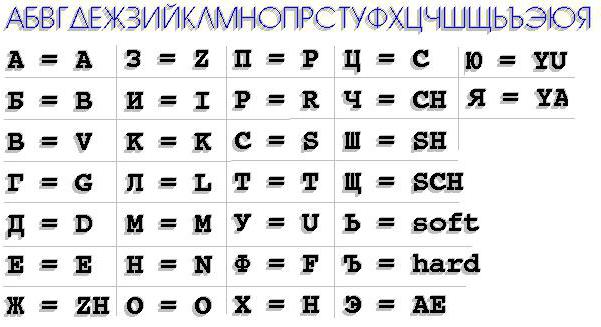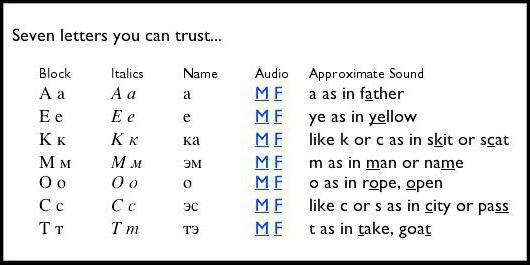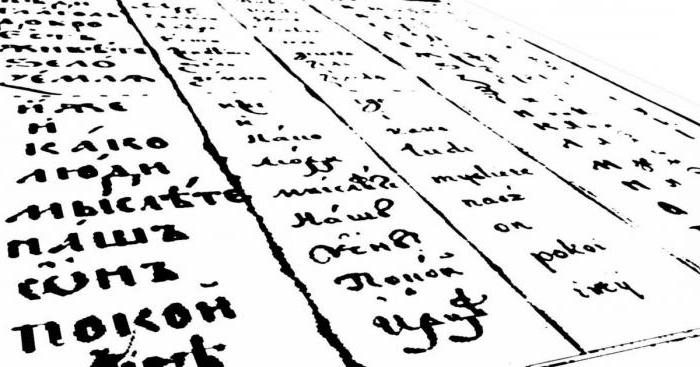The long-ago Latin spoken by the Romans has left behind an indelible mark. We are talking about all European languages, which are divided into Romance and Germanic. As for the Slavic peoples, a fundamentally new writing was developed especially for them, in which echoes of Europe and the Balkans could be traced. Thus, the main alphabets among the Slavic-European peoples became the Cyrillic and Latin alphabets, which we still use today.
Are foreign words in Russian written in Cyrillic or Latin alphabet? The question reveals some shortcomings in understanding how non-Latin script languages work. But this is an interesting question, and there are two points behind it. Cyrillic is the only correct script used in Russian. There are some "translits", but none of these "translits" are official, and there is no universal standard for them. In principle, yes: all foreign words and foreign names are written in Cyrillic.
Another thing is that not all native Russians even know latin alphabet. Yes, it is usually taught in school, but there may be people who don't know it, and of course you cannot require them to learn a foreign alphabet. That's why the question seems so strange to me. It's the same if you asked, "How do you say the name of the current Chinese president in English: do you use Chinese characters or transliterate it into the Latin alphabet?"
Origin of languages
The sources by which one can calculate the birth of a particular language are very vague. To this day, ancient linguistics and etymology constitute one of the greatest challenges for researchers. However, the Cyrillic and Latin alphabets are an exception, since the origin of these alphabets is more or less clear.
Latin
We will start with the language that was spoken in Ancient Rome, and which today, although dead, is widely used in medicine, history and philology. The prototype of Latin was the Etruscan unwritten language, which existed mainly in oral form and was used among the tribes of the same name inhabiting the center of modern Italy.
But another important problem why the Russian language does not preserve the original Latin orthography is that different languages that use this alphabet have different rules reading: for each Latin letter on different languages there is no universal phonetic meaning.
And it would be even more difficult to force everyone to know the reading rules specific to each Latin language! Some languages take care of their own correct pronunciation, rather than its original spelling in the original language. Main goal writer - let native speakers read foreign word as close as possible to its original pronunciation. Quiet letters are completely foreign to Russians, and most Russians didn't even understand why it was written one way and pronounced another way!
The new Roman civilization systematized all the dialects and developments of its ancestors, forming a full-fledged Latin alphabet. It consisted of 21 letters: A B C D E F H I K L M N O P Q R S T V X Z. After the collapse of the Roman Empire, Latin spread widely throughout Europe and assimilated into various tribal languages (Celtic, Welsh, Gothic, etc.).
All we need is what the name sounds like. Another example: consider the English "Bill Mike". Other languages take care of the original spelling by introducing words from other Latin languages. Although this approach seems very strange to me, I just have to accept this fact - it's a different language with its own rules. However, this does not always allow English speaking readers to know how to pronounce a word.
Hope this answers your question. The transition to the Latin script in Uzbekistan faces numerous obstacles, due to a lack of resources to reuse the Uzbek version of the alphabet, which has delayed and confused things. Even stranger, the Russian words that have been transliterated into romanized Uzbek may cause red faces. One notable example is Russian word"shop", which describes any type of industrial production. This is done in Uzbek as "sex".
This is how the languages of the Romance-Germanic group appeared - French, Italian, German, English and many others. Today, a single alphabet consisting of 26 letters is used to write them.

Old Church Slavonic
For the Slavic peoples, Latin was alien and unacceptable. But given the fact that some lands were subject to papal authority, while others adopted Orthodox Christianity, it was necessary to teach people the Holy Word. The Greek brothers Cyril and Methodius created an alphabet of 43 letters, which became understandable to the Slavic people.
Much to the delight of the schoolchildren, the sausage can be seen carrying signs that read "sausage sexy". When Sarvar Otamuradov ran for president in Uzbekistan last year, one of his main campaign promises was to promote the full adoption of the Latin alphabet.
The tone of Otamuradov's platform is best illustrated by the name of his party, Milliy Tiklanish or National Revival. According to proponents of the Latinization of the Uzbek language, the transition from the Cyrillic alphabet imposed by the Soviet language will allow the nation to fully assert its national identity.
It was named after his older brother Cyril, and it became the basis for the new Old Church Slavonic language. Later, the number of letters was reduced, and the language itself spread over very vast territories. Of course, it underwent changes due to various dialects, and as a result it split into many independent languages. This alphabet became the basis for Eastern European, Southern European and Russian scriptures.
Modern international writing systems
Critics of the idea fear that implementing these plans will be too expensive and will complicate the lives of many people for whom intimate knowledge of the Cyrillic script is a matter of economic survival. The issue has been on the public agenda for a quarter of a century.
But the debate has actually been raging for several years. Some outliers even suggested a return to the Arab scenario. After all, those who argue, for example, that familiarity with the Latin alphabet will facilitate adoption modern technologies, such as computers, won the day.

Modern international writing systems
Nowadays, the Cyrillic and Latin alphabet are used to exchange information internationally, even in eastern countries. These are two universal alphabets that have similar structure and symbols, and they are also able to replace each other. But it is worth noting that each of them has its own advantages.
The plan was to instill a knowledge of Roman letters adapted to the needs of Uzbekistan, and gradually move towards completing the formal transition to. Russian state media were predictably alarmed at the time. It is curious that during the years of perestroika, the local intelligentsia condemned the communist authorities for their violence against the Uzbek language, which, in their opinion, led to alienation from spiritual roots and ancient literary heritage. They said that by changing the alphabet twice, people were saddled with illiteracy.
Where are Latin letters and numbers currently used?
“They don’t seem to remember all this now,” wrote a journalist from the Tashkent newspaper in the Berezovsky newspaper. Immune to such bricks, Uzbek authorities began creating new school textbooks, and adults received crash courses in the updated alphabet. A lack of resources and consistency in the application of rules further delayed progress, and leading scholars such as cultural historian Artem Kosmarsky reflected on the prevailing confusion many years later.
Undoubtedly, the Latin alphabet is more common on the globe. With its help, many Chinese and Japanese words are written, it is widely used in banking documents (even in Russia) for recording personal data. But any linguist will tell you for sure that the Cyrillic alphabet is a much richer and more convenient alphabet due to the fact that its symbols convey a greater range of sounds.
Vowels and diphthongs
Perhaps recognizing the embarrassment of missing targets, officials have recently avoided paying too much attention to the issue. Ankara was clearly trading on the status of its role, hoping to supplant Russia as the “big brother” in the region. Of the former Soviet Turkic peoples, the first to take the plunge was Azerbaijan. By the first year of independence, first-graders received textbooks on the Roman script. The look of the Latin alphabet is now omnipresent, and the Cyrillic alphabet has accordingly largely disappeared from public opinion.
As for Uzbekistan, this is the third alphabet reform that will take place in the modern Uzbek state. This Cyrillic alphabet was not introduced at the time partly due to concerns about nationalist anti-Russian backlash in the region, where such sentiment was still high as a result of decades of anti-Sarist and later anti-Bolshevik insurgency. Moscow associated the Arabic alphabet with Islam and consequently saw the adoption of a new way of writing as a quick path to discarding what they saw as obscurantism and superstition.

"Alphabet" reforms
Replacing the Cyrillic alphabet with the Latin alphabet is a very important issue that has repeatedly arisen in many Slavic states. For the first time, Latin writing replaced Slavic in the Polish-Lithuanian Commonwealth and the Principality of Lithuania. Until now, Lithuania and Poland, despite the Slavic roots of their languages, use the Latin alphabet.
Views remain mixed about what Uzbekistan should do now. Political scientist Anvar Nazirov said he believed that while the move to the Latin script was the right idea, the execution was poor and that the views of experts were ignored.
There was no competent organization involved in introducing the new alphabet into bureaucratic proceedings, he said. The main argument against the Latin alphabet is cost. This transition will make life difficult for young people, especially those planning to work in Russia and Kazakhstan, as it will complicate their communication with the local population and limit their ability to fulfill their professional responsibilities, said veteran journalist Elparid Khodzhaev.
The translation from Cyrillic to Latin also affected South European countries. For example, Romania, which used the Cyrillic script, adopted the Latin alphabet in the 19th century. They did the same in Montenegro, Serbia and the Czech Republic.
What Russia went through
On the territory of our state, the Cyrillic and Latin alphabet have repeatedly fought for a place in the sun. Undoubtedly, the Cyrillic script was native to the Russian people, but repeated attempts to Catholicize the country suggested abandoning it and introducing the Latin alphabet as the basis of written speech.
Currently, the Latin alphabet is fully included in the program of Uzbekistan. It is also used interchangeably with Cyrillic in road signs and on the subway. But newspaper editors resisted similar efforts, fearing disaster for their circulation. Meanwhile, the Uzbek Internet has more or less adopted Latin and Cyrillic. For example, many official government websites provide Uzbek texts in both versions, as do some news websites.
However, the red ribbon is still the domain of the Cyrillic alphabet. These pages are intended to help Anglo-German academic researchers become skilled in translating the written records of the Napoleonic Church written in Cyrillic. All examples are taken from records obtained from Trinity Lutheran Church in Lublin, Poland, and therefore almost all cities or places presented in the translation examples of these pages correspond to cities in the Lublin Province.
First from Slavic alphabet Peter the Great wanted to refuse. He even carried out a language reform, throwing out many letters from the alphabet and replacing some of them with European ones. But later he abandoned this idea, returning everything to its place.

The second attempt to Latinize Russian society occurred after the revolution. At that time, Lenin carried out a unification reform. European units of measurement were adopted, a transition to the European calendar took place, and it was assumed that the language would also be translated.
What are Latin letters?
The first important skill to learn is the ability to recognize the handwritten Cyrillic letters found in these old documents. It is useful to match the letters of the script with in block letters, which are currently used in books or displayed on a computer. Here's a great table of handwritten letters with printed copies and the corresponding phonetics for each character in English, Polish and German.
As we encounter more writing styles in different years, we will try to include additional examples of these translated entries, showing different writing styles. Please note that these posts follow a specific format and usually the most important information can be gleaned by posting the important names and information associated with each name. More information about the format of each record type is provided on the Napoleonic Formats page.
Linguists have done a tremendous amount of work to change all Russian sources that were written in Cyrillic. But Stalin, who soon came to power, realized that the idea was devoid of common sense, and returned everything to normal.
Latin and Cyrillic: the difference
It is impossible not to notice that these two alphabets are incredibly similar to each other. They even contain absolutely identical letters: A, B, E, K, M, N, O, R, S, T, U, X. But as was rightly noted above, the functionality of the Cyrillic alphabet is much wider. Due to letters such as “Ш” or “Ш”, for example, a sound is transmitted, which is written in Latin using two, three or four characters.
Tables showing Russian inscriptions of important words such as numbers, months, and some critical terms are presented on these pages to assist the researcher in translating these important variables into each entry. Typically, the most difficult aspect of translation is deciphering city names, since standard Russian spelling is not provided for Polish cities. We are building a collection of examples of translating a city into pictures, arranged alphabetically in accordance with the Cyrillic alphabet. Since the phonetics of German and Polish languages better resemble the phonetics of Russian characters than what is used English language, the German phonetic translation is given in red under each handwritten city name.
It is worth mentioning separately about the letters “S” and “K”, which in our writing are strictly distinguished by sound. And in groups, their transcription depends on the vowel in front. Well, the most important thing that distinguishes the Latin alphabet from the Cyrillic alphabet is that each sound has a corresponding letter.
The combination of letters in a word does not affect their sound, doubling consonants are pronounced clearly, there are no silent vowels or silent syllables.
Above the city name, printed Cyrillic characters are presented in blue. Then the correct indication of the current day in this city is Polish language provided in black. These examples can be used to quickly learn to read handwritten Cyrillic and get the phonetic pronunciation of these city names.
Just as city names are transcribed phonetically on recordings, the surnames of witnesses or godparents in particular are also transcribed phonetically using Cyrillic characters. Using recordings from Lublin, we found that German names translate very effectively using this phonetic conversion.
In the 5th century BC e. Latin(self-name Lingua Latina) was one of the many Italic languages spoken in central Italy. Latin was used in the area known as Latium (modern name is Latium), and Rome was one of the cities in this area. The earliest inscriptions in Latin date back to the 6th century. BC e. and are made using an alphabet based on the Etruscan script.
Gradually, Rome's influence spread to other parts of Italy, and through them to Europe. Over time, the Roman Empire conquered Europe, North Africa and the Middle East. Throughout the empire, Latin came to be used as the language of law and authority, and, increasingly, as the language of everyday life. The Romans were literate, and many of them read the works of famous Latin authors.
Meanwhile, in the eastern Mediterranean Greek remained a lingua franca, and educated Romans were bilingual. The earliest examples of Latin literature known to us are translations of Greek plays and Cato's agricultural manual into Latin, dating back to 150 BC. e.
Classical Latin, which was used in early works of Latin literature, differed in many ways from colloquial, so-called Vulgar Latin. However, some writers, including Cicero and Petronius, used Vulgar Latin in their writings. Over time, the spoken variants of the Latin language moved further and further away from the literary standard, and gradually, on their basis, Italic/Romance languages (Spanish, Portuguese, etc.) appeared.
Even after the collapse of the Western Roman Empire in 476, Latin continued to be used as a literary language in Western and Central Europe. A huge amount of medieval Latin literature appeared in a variety of styles - from scientific works of Irish and Anglo-Saxon writers to simple tales and sermons intended for the general public.
Throughout the 15th century. Latin began to lose its dominant position and title as the main language of science and religion in Europe. It has been largely replaced by written versions of local European languages, many of which are derived from or influenced by Latin.
Modern Latin was used by the Roman Catholic Church until the mid-20th century, and currently continues to exist to some extent, especially in the Vatican, where it is recognized as one of the official languages. Latin terminology is actively used by biologists, paleontologists and other scientists to name species and preparations, as well as by doctors and lawyers.
Latin alphabet
The Romans used only 23 letters to write Latin:
Didn't exist in Latin lowercase letters. The letters I and V could be used as consonants and vowels. The letters K, X, Y and Z were used only to write words of Greek origin.
The letters J, U and W were added to the alphabet later to write languages other than Latin.
The letter J is a variant of I and was first introduced into use by Pierre de la Ramais in the 16th century.
The letter U is a variant of V. In Latin, the sound /u/ was represented by the letter v, for example IVLIVS (Julius).
The letter W was originally a double v (vv) and was first used by Old English scribes in the 7th century, although the runic letter Wynn (Ƿ) was more commonly used to represent the /w/ sound in writing. After the Norman Conquest, the letter W became more popular and by 1300 had completely replaced the letter Wynn.
Reconstructed phonetic transcription of classical Latin
Vowels and diphthongs
Consonants

Notes
- Vowel length was not shown in writing, although modern editions of classical texts use a macron (ā) to indicate long vowels.
- The pronunciation of short vowels in the medial position is different: E [ɛ], O [ɔ], I [ɪ] and V [ʊ].
Phonetic transcription of ecclesiastical Latin
Vowels
Diphthongs
Consonants

Notes
- Double vowels are pronounced separately
- C = [ʧ] before ae, oe, e, i or y, and [k] in any other positions
- G = [ʤ] before ae, oe, e, i or y, and [g] in any other positions
- H is not pronounced except in words mihi And nihil, where the sound /k/ is pronounced
- S = [z] between vowels
- SC = [ʃ] before ae, oe, e, i or y, and in any other positions
- TI = before the vowel a and after all letters except s, t or x, and in any other positions
- U = [w] after q
- V = [v] at the beginning of a syllable
- Z = at the beginning of a word before vowels, and before consonants or at the end of a word.



